Abstract
1. In this study the influence of nitric oxide (NO) on the bronchoconstriction induced by bradykinin in anaesthetized and artifically ventilated guinea-pigs pretreated with atropine was investigated. 2. Aerosol administration of bradykinin (0.1-1 mM, 40 breaths) caused a dose-dependent increase in lung resistance (RL): maximum increase in RL was 2.5 fold the baseline value. Pretreatment with aerosolized NG-nitro-L-arginine methyl ester (L-NAME) or NG-monomethyl-L-arginine (L-NMMA) (1 mM, 10 breaths every 5 min for 30 min), NO synthase inhibitors, markedly increased the bronchoconstrictor response to bradykinin. L-Arginine, but not D-arginine, (3 mM, 10 breaths every 5 min for 30 min) reversed the hyperresponsiveness to aerosolized bradykinin caused by L-NAME and L-NMMA. 3. L-NAME (1 mM, 10 breaths every 5 min for 30 min) increased the bronchoconstriction induced by intravenous bradykinin (1-10 nmol kg-1). L-Arginine, but not D-arginine, (10 breaths every 5 min for 30 min) reversed the hyperresponsiveness to intravenous bradykinin caused by L-NAME. 4. The increase in RL induced by capsaicin, either aerosol (10 microM, 10 breaths) or i.v. (20 nmol kg-1) was not affected by L-NAME (1 mM, 10 breaths every 5 min for 30 min). Acute resection of the vagi did not affect the bronchoconstriction evoked by bradykinin in guinea-pigs, either in the absence or presence of L-NAME (1 mM, 10 breaths every 5 min for 30 min).(ABSTRACT TRUNCATED AT 250 WORDS)
Full text
PDF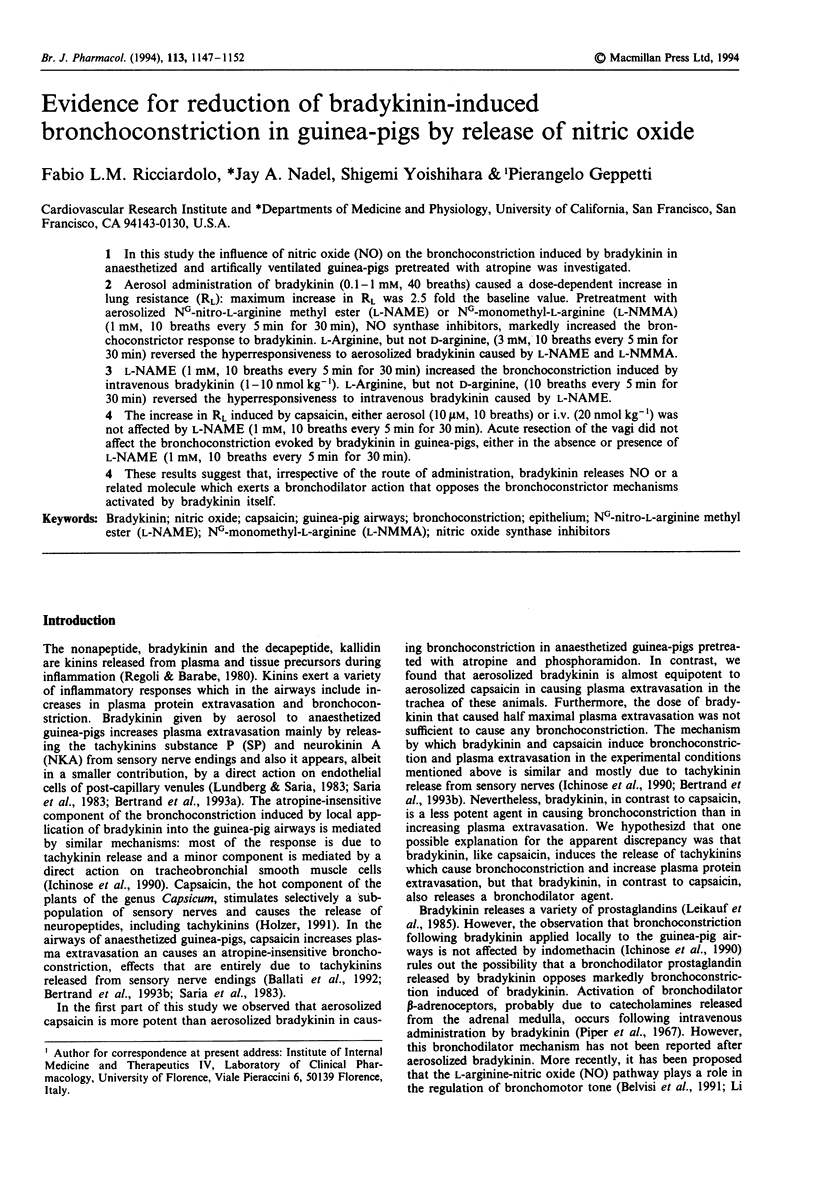
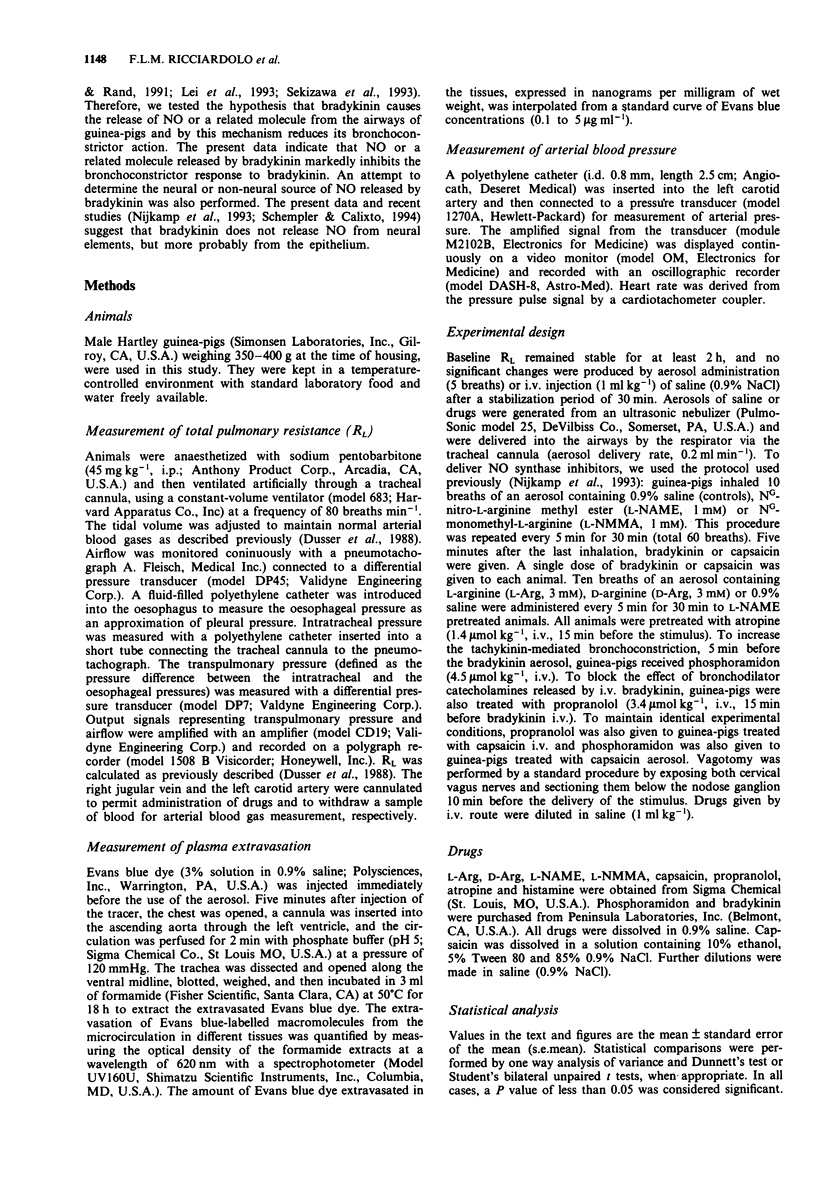
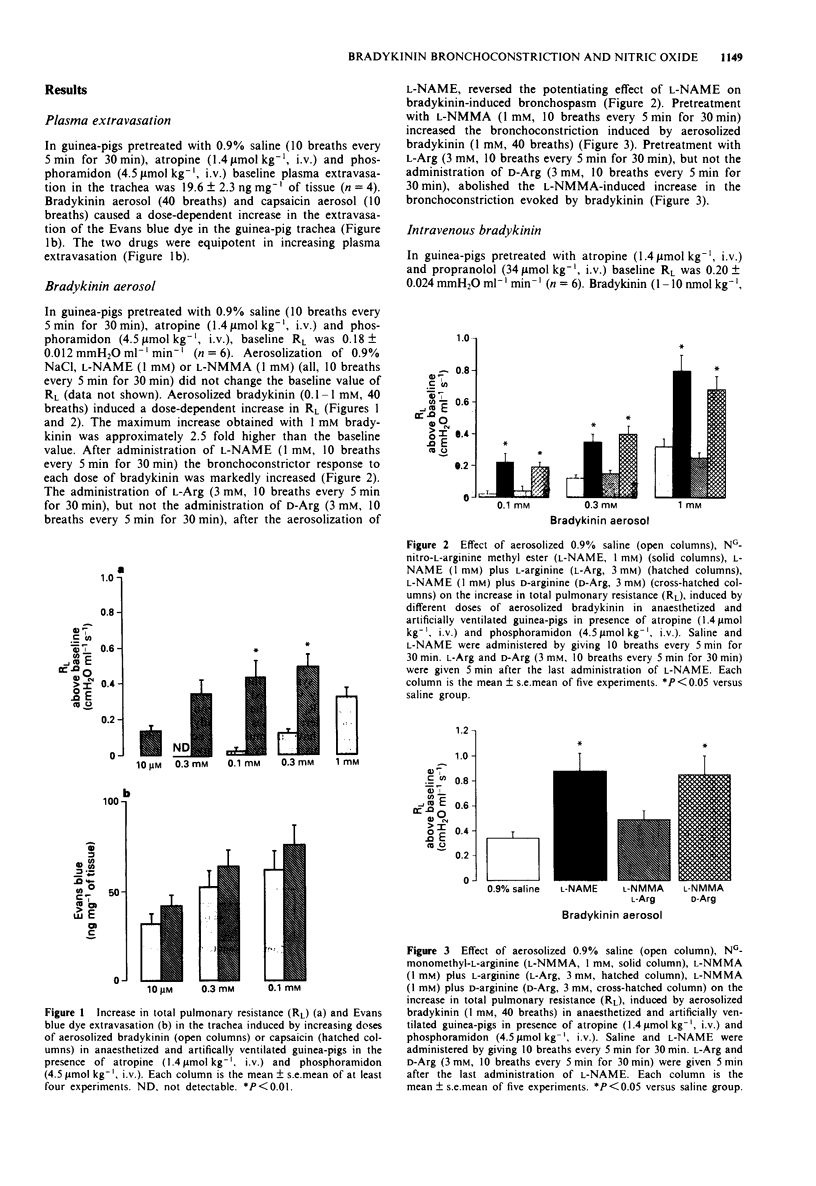
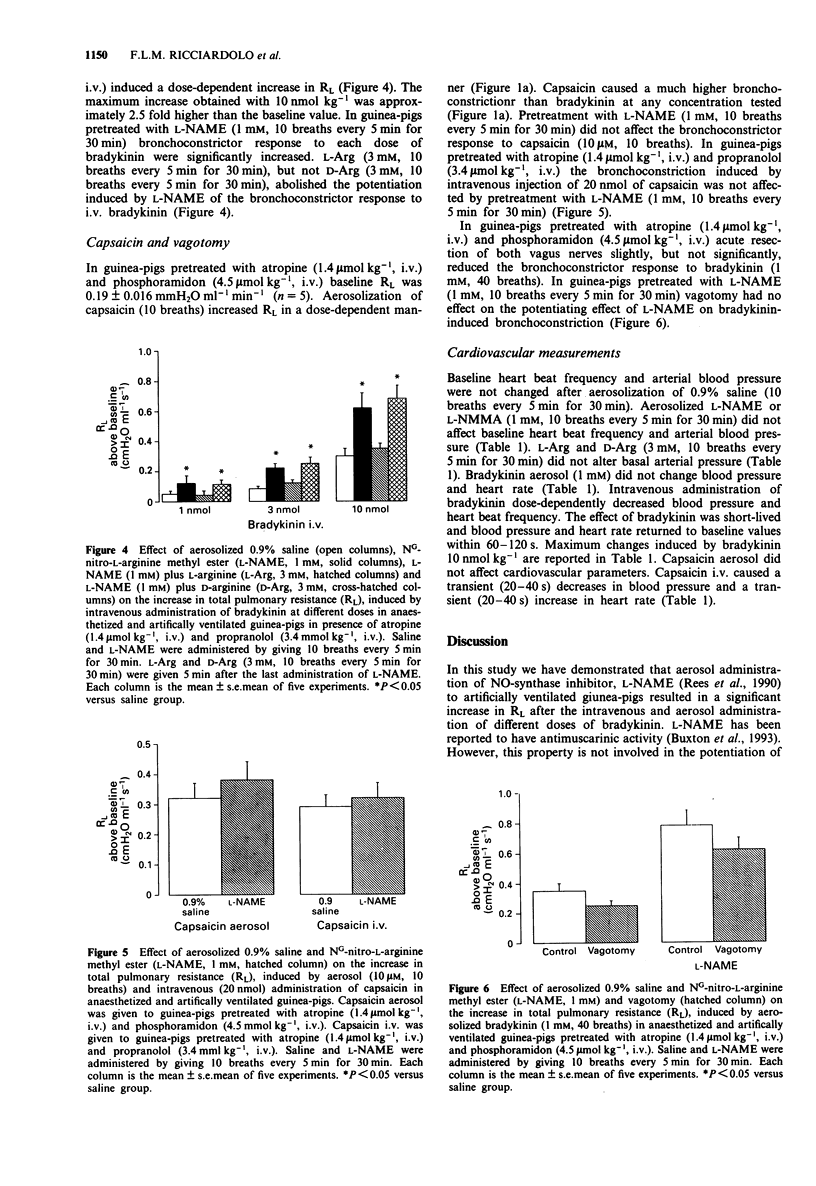
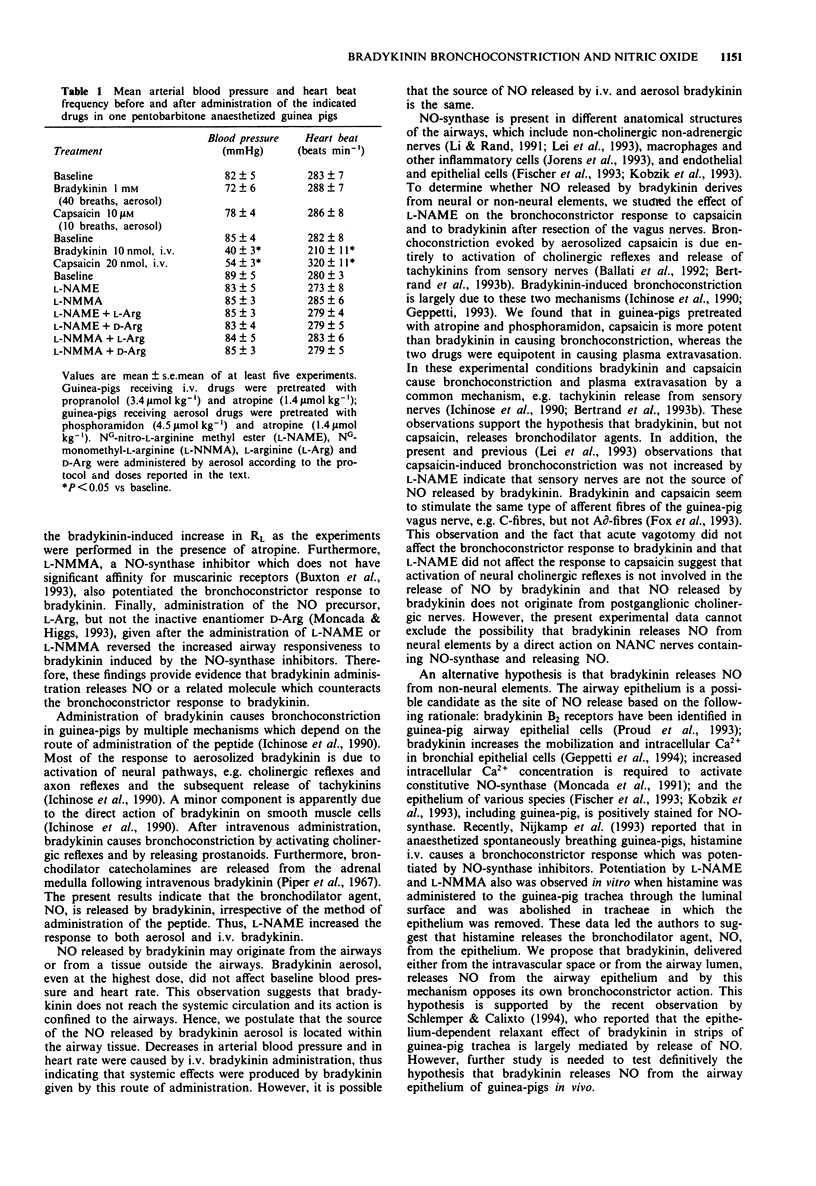
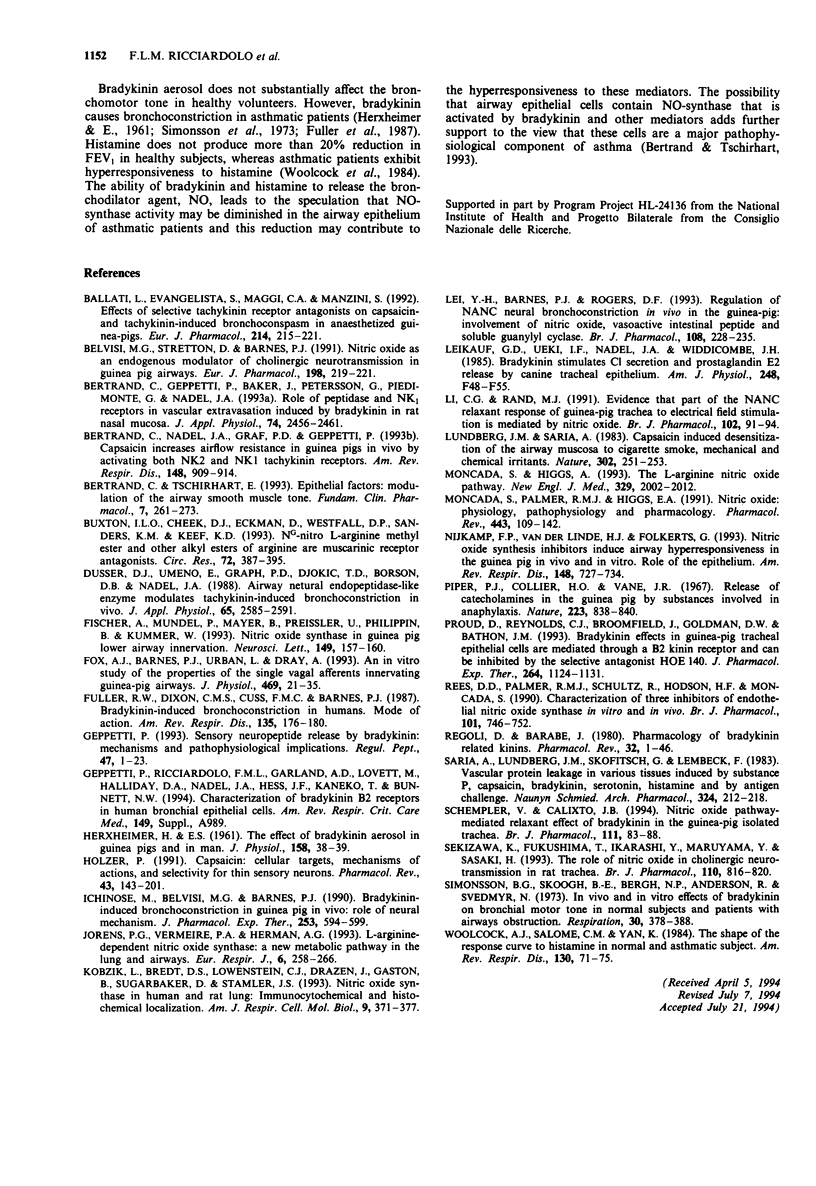
Selected References
These references are in PubMed. This may not be the complete list of references from this article.
- Ballati L., Evangelista S., Maggi C. A., Manzini S. Effects of selective tachykinin receptor antagonists on capsaicin- and tachykinin-induced bronchospasm in anaesthetized guinea-pigs. Eur J Pharmacol. 1992 Apr 22;214(2-3):215–221. doi: 10.1016/0014-2999(92)90121-j. [DOI] [PubMed] [Google Scholar]
- Belvisi M. G., Stretton D., Barnes P. J. Nitric oxide as an endogenous modulator of cholinergic neurotransmission in guinea-pig airways. Eur J Pharmacol. 1991 Jun 6;198(2-3):219–221. doi: 10.1016/0014-2999(91)90626-2. [DOI] [PubMed] [Google Scholar]
- Bertrand C., Geppetti P., Baker J., Petersson G., Piedimonte G., Nadel J. A. Role of peptidases and NK1 receptors in vascular extravasation induced by bradykinin in rat nasal mucosa. J Appl Physiol (1985) 1993 May;74(5):2456–2461. doi: 10.1152/jappl.1993.74.5.2456. [DOI] [PubMed] [Google Scholar]
- Bertrand C., Nadel J. A., Graf P. D., Geppetti P. Capsaicin increases airflow resistance in guinea pigs in vivo by activating both NK2 and NK1 tachykinin receptors. Am Rev Respir Dis. 1993 Oct;148(4 Pt 1):909–914. doi: 10.1164/ajrccm/148.4_Pt_1.909. [DOI] [PubMed] [Google Scholar]
- Bertrand C., Tschirhart E. Epithelial factors: modulation of the airway smooth muscle tone. Fundam Clin Pharmacol. 1993;7(6):261–273. doi: 10.1111/j.1472-8206.1993.tb00240.x. [DOI] [PubMed] [Google Scholar]
- Buxton I. L., Cheek D. J., Eckman D., Westfall D. P., Sanders K. M., Keef K. D. NG-nitro L-arginine methyl ester and other alkyl esters of arginine are muscarinic receptor antagonists. Circ Res. 1993 Feb;72(2):387–395. doi: 10.1161/01.res.72.2.387. [DOI] [PubMed] [Google Scholar]
- Dusser D. J., Umeno E., Graf P. D., Djokic T., Borson D. B., Nadel J. A. Airway neutral endopeptidase-like enzyme modulates tachykinin-induced bronchoconstriction in vivo. J Appl Physiol (1985) 1988 Dec;65(6):2585–2591. doi: 10.1152/jappl.1988.65.6.2585. [DOI] [PubMed] [Google Scholar]
- Fischer A., Mundel P., Mayer B., Preissler U., Philippin B., Kummer W. Nitric oxide synthase in guinea pig lower airway innervation. Neurosci Lett. 1993 Jan 12;149(2):157–160. doi: 10.1016/0304-3940(93)90760-i. [DOI] [PubMed] [Google Scholar]
- Fox A. J., Barnes P. J., Urban L., Dray A. An in vitro study of the properties of single vagal afferents innervating guinea-pig airways. J Physiol. 1993 Sep;469:21–35. doi: 10.1113/jphysiol.1993.sp019802. [DOI] [PMC free article] [PubMed] [Google Scholar]
- Fuller R. W., Dixon C. M., Cuss F. M., Barnes P. J. Bradykinin-induced bronchoconstriction in humans. Mode of action. Am Rev Respir Dis. 1987 Jan;135(1):176–180. doi: 10.1164/arrd.1987.135.1.176. [DOI] [PubMed] [Google Scholar]
- Geppetti P. Sensory neuropeptide release by bradykinin: mechanisms and pathophysiological implications. Regul Pept. 1993 Aug 13;47(1):1–23. doi: 10.1016/0167-0115(93)90268-d. [DOI] [PubMed] [Google Scholar]
- Holzer P. Capsaicin: cellular targets, mechanisms of action, and selectivity for thin sensory neurons. Pharmacol Rev. 1991 Jun;43(2):143–201. [PubMed] [Google Scholar]
- Ichinose M., Belvisi M. G., Barnes P. J. Bradykinin-induced bronchoconstriction in guinea pig in vivo: role of neural mechanisms. J Pharmacol Exp Ther. 1990 May;253(2):594–599. [PubMed] [Google Scholar]
- Jorens P. G., Vermeire P. A., Herman A. G. L-arginine-dependent nitric oxide synthase: a new metabolic pathway in the lung and airways. Eur Respir J. 1993 Feb;6(2):258–266. [PubMed] [Google Scholar]
- Kobzik L., Bredt D. S., Lowenstein C. J., Drazen J., Gaston B., Sugarbaker D., Stamler J. S. Nitric oxide synthase in human and rat lung: immunocytochemical and histochemical localization. Am J Respir Cell Mol Biol. 1993 Oct;9(4):371–377. doi: 10.1165/ajrcmb/9.4.371. [DOI] [PubMed] [Google Scholar]
- Lei Y. H., Barnes P. J., Rogers D. F. Regulation of NANC neural bronchoconstriction in vivo in the guinea-pig: involvement of nitric oxide, vasoactive intestinal peptide and soluble guanylyl cyclase. Br J Pharmacol. 1993 Jan;108(1):228–235. doi: 10.1111/j.1476-5381.1993.tb13467.x. [DOI] [PMC free article] [PubMed] [Google Scholar]
- Leikauf G. D., Ueki I. F., Nadel J. A., Widdicombe J. H. Bradykinin stimulates Cl secretion and prostaglandin E2 release by canine tracheal epithelium. Am J Physiol. 1985 Jan;248(1 Pt 2):F48–F55. doi: 10.1152/ajprenal.1985.248.1.F48. [DOI] [PubMed] [Google Scholar]
- Li C. G., Rand M. J. Evidence that part of the NANC relaxant response of guinea-pig trachea to electrical field stimulation is mediated by nitric oxide. Br J Pharmacol. 1991 Jan;102(1):91–94. doi: 10.1111/j.1476-5381.1991.tb12137.x. [DOI] [PMC free article] [PubMed] [Google Scholar]
- Lundberg J. M., Saria A. Capsaicin-induced desensitization of airway mucosa to cigarette smoke, mechanical and chemical irritants. Nature. 1983 Mar 17;302(5905):251–253. doi: 10.1038/302251a0. [DOI] [PubMed] [Google Scholar]
- Moncada S., Higgs A. The L-arginine-nitric oxide pathway. N Engl J Med. 1993 Dec 30;329(27):2002–2012. doi: 10.1056/NEJM199312303292706. [DOI] [PubMed] [Google Scholar]
- Moncada S., Palmer R. M., Higgs E. A. Nitric oxide: physiology, pathophysiology, and pharmacology. Pharmacol Rev. 1991 Jun;43(2):109–142. [PubMed] [Google Scholar]
- Nijkamp F. P., van der Linde H. J., Folkerts G. Nitric oxide synthesis inhibitors induce airway hyperresponsiveness in the guinea pig in vivo and in vitro. Role of the epithelium. Am Rev Respir Dis. 1993 Sep;148(3):727–734. doi: 10.1164/ajrccm/148.3.727. [DOI] [PubMed] [Google Scholar]
- Piper P. J., Collier H. O. Release of catecholamines in the guinea-pig by substances involved in anaphylaxis. Nature. 1967 Feb 25;213(5078):838–840. doi: 10.1038/213838a0. [DOI] [PubMed] [Google Scholar]
- Proud D., Reynolds C. J., Broomfield J., Goldman D. W., Bathon J. M. Bradykinin effects in guinea pig tracheal epithelial cells are mediated through a B2 kinin receptor and can be inhibited by the selective antagonist Hoe 140. J Pharmacol Exp Ther. 1993 Mar;264(3):1124–1131. [PubMed] [Google Scholar]
- Rees D. D., Palmer R. M., Schulz R., Hodson H. F., Moncada S. Characterization of three inhibitors of endothelial nitric oxide synthase in vitro and in vivo. Br J Pharmacol. 1990 Nov;101(3):746–752. doi: 10.1111/j.1476-5381.1990.tb14151.x. [DOI] [PMC free article] [PubMed] [Google Scholar]
- Regoli D., Barabé J. Pharmacology of bradykinin and related kinins. Pharmacol Rev. 1980 Mar;32(1):1–46. [PubMed] [Google Scholar]
- Saria A., Lundberg J. M., Skofitsch G., Lembeck F. Vascular protein linkage in various tissue induced by substance P, capsaicin, bradykinin, serotonin, histamine and by antigen challenge. Naunyn Schmiedebergs Arch Pharmacol. 1983 Nov;324(3):212–218. doi: 10.1007/BF00503897. [DOI] [PubMed] [Google Scholar]
- Schlemper V., Calixto J. B. Nitric oxide pathway-mediated relaxant effect of bradykinin in the guinea-pig isolated trachea. Br J Pharmacol. 1994 Jan;111(1):83–88. doi: 10.1111/j.1476-5381.1994.tb14027.x. [DOI] [PMC free article] [PubMed] [Google Scholar]
- Sekizawa K., Fukushima T., Ikarashi Y., Maruyama Y., Sasaki H. The role of nitric oxide in cholinergic neurotransmission in rat trachea. Br J Pharmacol. 1993 Oct;110(2):816–820. doi: 10.1111/j.1476-5381.1993.tb13885.x. [DOI] [PMC free article] [PubMed] [Google Scholar]
- Simonsson B. G., Skoogh B. E., Bergh N. P., Andersson R., Svedmyr N. In vivo and in vitro effect of bradykinin on bronchial motor tone in normal subjects and patients with airways obstruction. Respiration. 1973;30(4):378–388. doi: 10.1159/000193051. [DOI] [PubMed] [Google Scholar]
- Woolcock A. J., Salome C. M., Yan K. The shape of the dose-response curve to histamine in asthmatic and normal subjects. Am Rev Respir Dis. 1984 Jul;130(1):71–75. doi: 10.1164/arrd.1984.130.1.71. [DOI] [PubMed] [Google Scholar]


